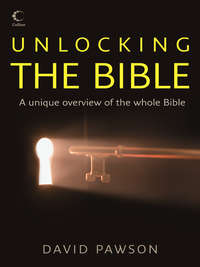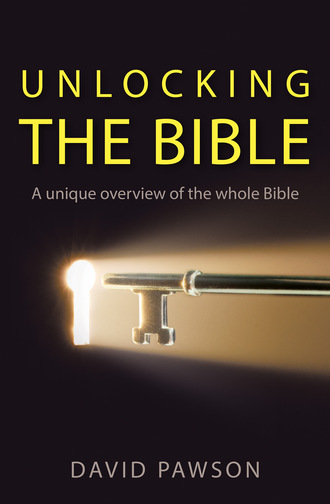
Полная версия
Unlocking the Bible
At the same time there are some significant differences. We are not now under the law of Moses but under the law of Christ. As we shall see, in some ways this makes things harder and in other ways it makes them easier.
The tabernacle is no longer necessary, for we know that Christ has provided direct access into the holy of holies. Neither are we dependent on God’s provision of food and water from the sky and the rock.
There are two essential ways in which Christians need to apply Exodus today.
Christ
Christians are to seek Christ in the book of Exodus. Jesus said, ‘Search the Scriptures, for they bear witness to me.’ The Exodus is central to the Old Testament, and all the books which follow look back to it as the redemption on which everything else is based. In the same way the cross is central to the New Testament.
This is not a fanciful connection. Six months before Jesus died on the cross he was 4,000 feet high on top of Mount Hermon in the north of Israel, talking with Moses and Elijah. Luke’s Gospel tells us that they talked about ‘the exodus’ which Jesus was about to accomplish in Jerusalem.
What is more, Jesus died at 3.00 p.m., the very time when thousands of Passover lambs were being slaughtered. So Christ is called ‘our Passover lamb’, the one who has been sacrificed for us so that the angel of death would pass over those who trust in him. He rose from the dead on the third day and his resurrection liberates us from death, just as the Hebrews were liberated from slavery on the third day after the Passover.
There are other links, too. We read in John’s Gospel that Jesus is the bread from heaven. Paul says that Jesus is the rock from which Moses drew the water for the children of Israel. John also says in his Gospel that ‘the word became flesh and “tabernacled among us”’. He literally pitched his tent, God in Christ dwelling in the midst of his people.
With all this in mind, we can understand Christ’s words in Matthew: ‘I did not come to destroy the law but to fulfil it’. In short, we cannot understand the New Testament without the Old.
Christians
The book of Exodus can also be applied to Christians. Paul, reflecting on some of the events in Exodus, writes to the church at Corinth: ‘These things occurred as examples, to keep us from setting our hearts on evil things, as they did.’
The crossing of the Red Sea prefigures baptism. Paul says the children of Israel were baptized into Moses in the Red Sea and his readers had been baptized into Christ.
Christians also have a Passover meal regularly, for the Lord’s Supper is a Passover meal, commemorating the liberation of Christ.
Paul speaks of keeping the feast and getting rid of the yeast or leaven because Christ the Passover lamb has been sacrificed. This seems a strange exhortation until we consider the context. He was writing to a church about the immoral behaviour of a believer who was sleeping with his stepmother. In this context the yeast stood for the evil that was taking place which needed to be got rid of if they were truly to ‘keep the feast’. The Exodus account sees things in a material way, while the New Testament sees them in a moral context.
Many become especially concerned about how Christians should treat the laws given to Moses. It is true that we do not need to keep the law, but in many ways the ‘Law of Christ’ is much harder than the ‘law of Moses’. The law of Moses says ‘do not kill anybody’, and ‘do not commit adultery’. Many people are clear at that level, but the Law of Christ says ‘do not even think about it’. It is much harder to keep the Law of Christ than the law of Moses.
On the other hand, it is much easier in some ways because now we do not need a great number of priests, rituals and special buildings. The apostle John wrote, ‘For the law was given through Moses; grace and truth came through Jesus Christ.’ Whenever we pray we can enter the holiest place of all unhindered in the name of Jesus.
There is a big difference, too, between the New Covenant and the Old. Under the law given at Pentecost 3,000 died, but with the Spirit given at Pentecost 3,000 lived. I would rather have the Spirit who writes the law on the heart than the old law.
The theme of glory also has a new meaning for Christians. Paul compares the fading glory of Moses with the Spirit’s work in the New Covenant. Christians can know the same glory that Moses knew when he came down from the mountain. This glory, however, is not connected with altars, incense and robes but with the Spirit who indwells the believer. This glory increases day by day.
Finally, we must note the way in which the tabernacle speaks so powerfully of how we approach God today. We come first through sacrifice (the altar), justified through Christ, then we need cleansing by the Spirit (the laver). The colours of the tabernacle are significant: purple speaking of royalty, blue of heaven and white of purity. Today we have a High Priest who represents us before God, but one who needs no sacrifice for his own sins. He made the once-and-for-all sacrifice to which all the sacrifices under the Old Covenant point.
There is still to come a future deliverance for Christians equivalent to the Exodus. In Revelation we find that over half the plagues of Pharaoh are going to happen all over again. There is an astonishing correlation between the plagues at the end of history and the plagues which were visited on Pharaoh. Those who remain faithful to Jesus will come through these and be victorious. Chapter 15 of the book of Revelation says that the martyrs, and those who have overcome all the pressures of persecution outside and temptation inside, will sing the song of Moses. In Exodus 15 we have the first song recorded in the Bible, a song composed by Miriam to celebrate the drowning of the Egyptians in the Red Sea. This song will be sung when all this world’s troubles are over and we are safe in glory. We will have a double exodus to celebrate – the Exodus from Egypt and the exodus of the cross.
4.
LEVITICUS

Introduction
Many people who resolve to read the Bible all the way through get stuck in Leviticus. It is easy to understand why. It is a very difficult book to read, for three main reasons.
The first is that it is quite simply a boring book – it is like trying to read the telephone directory. It is so different in content from other books of the Bible, especially the first two, which are full of stories. In these books there is a plot, there is drama, things are moving. When you get into Leviticus there is hardly any narrative at all and, since many regard the Bible as a collection of stories, it is a great disappointment to arrive at a book which has no stories of any kind.
The second reason is that it is so unfamiliar. It is from a different culture as well as having a different content. We are moving away from our present situation by 3,000 years and 2,000 miles. It is a totally different world and we read about things that we find very strange. For example, consider the way they deal with infectious disease in Leviticus. The poor person has to tear their clothes, let their hair grow long and unbrushed, cover the lower part of their face and go around shouting, ‘Unclean! Unclean!’. In our society we deal with infectious diseases rather differently! It also includes other weird activities – we do not arrive at church today carrying a little lamb or a pigeon to give to the pastor, who then slits its throat in front of the whole congregation.
The third reason is that it seems to be so irrelevant. What has Leviticus got to say to me living today? At work on a Monday? Deep down we know instinctively that we are not under the law of Moses and, since this book is part of his law, we are not sure what – if anything – it has to do with us.
Context
Let us therefore consider the book with a view to overturning some of the misgivings we may have. Leviticus is one of five books that together make up what is called the Pentateuch (penta meaning ‘five’). These comprise the law of Moses. The Jews call it the Torah, the ‘Books of Instruction’, and they read it through once a year. They start on the eighth day of the Feast of Tabernacles, sometime in September/October, and beginning with Genesis 1, they read it through the year to finish at the next Feast of Tabernacles the following autumn.
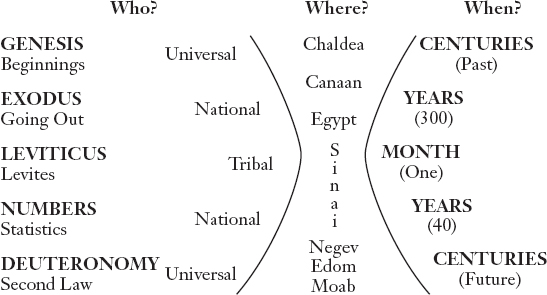
The interesting thing about the five books of Moses is that they have a distinctive and memorable shape. Noting this will help us put Leviticus in context. The diagram will make this clear.
ITS PLACE IN THE PENTATEUCH
Genesis is the book of beginnings: it is what the word ‘genesis’ means and it tells you how everything began, from the creation of our universe to Israel becoming the people of God. Exodus focuses on the Israelites going out from Egypt. Leviticus derives its name from the tribe of Levites, one of the tribes of Israel. The book of Numbers is precisely what it says: a book of statistics (600,000 men came out of Egypt, plus women and children, probably 2.5 million in all). Finally, Deuteronomy (deutero means ‘second’ and nomus means ‘law’) focuses on the second giving of the law (God gave his law twice, once at Sinai and once just before they crossed the Jordan into the Promised Land, so the Ten Commandments come twice – once in Exodus and once in Deuteronomy as a kind of reminder of the law just before they entered the Promised Land).
When we ask who these books are about, we begin to see the shape emerging. Genesis is a universal book – it is about everybody, the human race and the whole universe. Exodus is a national book – it zooms down on one people, the nation of Israel. In Leviticus the focus is even more narrow, on only one tribe out of the whole nation. Once past Leviticus, the focus opens out again and Numbers is about the whole nation once more. Deuteronomy puts Israel against the backcloth of the entire world and we are back to the universal viewpoint.
This shape helps to explain why so many people get stuck in Leviticus. While they are interested in universal things and even national things, they are less concerned when the focus is upon a particular tribe, other than their own.
ITS PLACE IN GEOGRAPHY
Genesis begins with the whole earth, then starts to focus in on the area of the Chaldees where Abraham lived, then on the land of Canaan to which he travelled, and then on Egypt where his descendants ended up. In the land of Egypt they became slaves for 400 years. In Leviticus the focus is once again very narrow, concentrating on just one place: Mount Sinai, where the law and regulations were given. The focus then expands with the journeys through the Negev, Edom and Moab, back into Canaan.
ITS PLACE IN TIME
Genesis covers centuries, all the past history of our earth. Exodus covers years, about 300. Leviticus only covers one month, while Numbers covers 40 years and Deuteronomy looks forward through the centuries to the future history of Israel. Once again we can see the shape of the five books of Moses. Leviticus is the hinge of the whole thing, focusing down to the most important month at the most important place with the most important tribe. The whole of the law of Moses hangs on this.
When the Jews read through the Pentateuch every 12 months, they spend about a fortnight to three weeks reading Leviticus.
Relation to Exodus
Having looked at Leviticus in the context of the Pentateuch, we should also relate it back to Exodus. It is very important to recognize how each book grows out of the previous book if we wish to understand it fully. In the second half of Exodus the tabernacle is built, God’s tent in which he lives among his people. If you imagine the camp in Exodus, God’s tent would be in the middle and hundreds of other tents all around it – the divine tent and the human tents together. Leviticus is about everything that goes on in God’s tent and everything that should go on in the people’s tents. So it divides into two halves: God’s tent and the people’s tents, with the rules and regulations for both.
Furthermore, when dealing with the tabernacle, Exodus talks about God’s approach to man, but Leviticus talks about man’s approach to God. Exodus is about the deliverance that God brought to his people, but Leviticus is about the dedication of God’s people to him. Exodus is about God’s grace in setting the people free, but Leviticus begins with thank offerings, explaining how the people can show their gratitude to God for being set free.
We need both books and their complementary messages. This book may not be as exciting as Exodus, but it shows that God expects something from us in return for what he has done for us. Once again we are reminded that we are saved in order to serve. Exodus shows how God saved his people, but Leviticus explains how they are to serve him.
‘Be holy’
When we read the Old Testament it can be helpful to imagine that we are Jewish. For a Jewish person the reason for reading Leviticus is clear: it is quite literally a matter of life and death. To the Jews there is only one God and that is the God of Israel. All other so-called gods are figments of human imagination. It was the same for the Israelites in Exodus and Leviticus. Since there was only one God and they were his only people on earth, there was a special relationship between them. On God’s side he promised to do many things for them: to be their government; to be their minister of defence and protect them; to be their minister of finance, so there would be no poor among them; to be their minister of health, so that none of the diseases of Egypt would touch them. God would be everything they needed, their King. In return he expected them to live right and to do things right. The biblical word is ‘righteous’ – ‘righteousness’ means living right. The key text in the whole of Leviticus is one that is frequently alluded to in the New Testament: ‘Be holy for I am holy’.
God expects the people he liberates to be like him and not like those around them. Many of the things which seem puzzling in Leviticus are explained by this fact. It is the key that unlocks the whole book. When God tells them that they must not do something, it is because the people around them are doing it but they are to be different, to be holy because he is holy. If God saves you he expects you to be like him; he expects you to live his way and to be holy as he is holy.
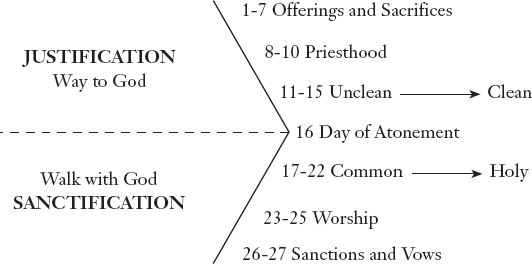
The shape of the book
We have noted already that the book is in two halves. It builds up to a climax and then flows out from the climax. It is also like a multi-layered sandwich. The chart shows that the first section corresponds to the sixth, the second to the fifth, and the third to the fourth, leaving one right in the middle. There are clear correspondences between these sections, beautifully put together and worked out.
Remember that God is responsible for this pattern, not Moses. In fact, there are more words of God in the book of Leviticus than in any other book in the Bible! About 90 per cent of Leviticus is the direct speech of God – ‘The LORD said to Moses…’ There is no other book in the Bible that has so much of God’s direct speech, so if you want to read God’s Word this is a good book to start with. You will be reading the actual words of God.
The offerings and sacrifices of the first seven chapters are backed up by the sanctions and vows of the people in the last section. The details about the priesthood correspond to the details about the worship that they are to lead.
The climax of the book is the Day of Atonement, the day on which two animals were used to symbolize the sins of the people. They sacrificed one animal, a sheep, inside the camp. One after another they then laid their hands on the other animal, a goat, and confessed their sins. They pushed the goat out of the camp into the wilderness, where it would die with all their sins loaded on it. It was called the ‘scapegoat’, a word we still have in common use today.
The two sections of the book pivot around the Day of Atonement. The first half describes our way to God – what we call justification – and the second half describes our walk with God – what is known as sanctification.
Offerings and worship
Let us look first at the opening seven chapters, which deal with the rules for offerings. There are five offerings, of two different types.
Gratitude offerings
The first three offerings were the right way to say ‘thank you’ to God for blessing. They were not offerings for sin but offerings of gratitude. If we feel grateful to God he wants us to say ‘thank you’.
For the burnt offering, an animal was brought, slaughtered and then burnt so that God could smell it. The sacrifice was said to be a sweet-smelling savour to him.
In a burnt offering the whole thing was burnt, but for a meal offering some was kept back so that the worshipper could have a meal with God. Part of the offering would be given to God and part would be eaten by the person making the offering.
The third gratitude offering was a peace offering, in which all the fat was burned.
Guilt offerings
The other two offerings were not to express gratitude but to deal with guilt. There was the sin offering and the trespass offering and these did two things.
First, they made atonement for sin. They offered God compensation for what the person had done wrong. The word ‘atonement’ does not mean ‘at-one-ment’ – that is a modern idea. It actually means ‘compensation’, so if you atone for something, you offer something as compensation. Both the sin offering and trespass offering are compensation offerings to God involving blood: as a compensation for the bad life the offerer has lived, they offer to God a good life that has not sinned.
Second, they only work for unintentional sins; they do not work for deliberate sins. In other words, nobody is perfect, we all make mistakes, we all fall into sin unintentionally. Even though we do not intend to do wrong, we do it. God provided offerings for unintentional sin, but there is no offering on this list for deliberate sin.
This is an important point which is picked up in the New Testament. The New Testament distinguishes between accidental and deliberate, wilful sin in Christians. Like the Old Testament, it says that if we deliberately sin after being forgiven, there is no more sacrifice for sin. Deliberate sin in those who have been forgiven is very serious, which is why Jesus said to the woman caught in adultery, ‘Go and sin no more’. For accidental sin, however, there is full provision, because God knows we are weak, knows we fall, and knows we do not always intend to do what we do. As Paul says in Romans: ‘The evil I would not, that I do.’ This distinction between deliberate sin and accidental sin in God’s people runs right through the New Testament as it does through the Old.
Worship calendar
As well as bringing offerings to God, the Jews had a calendar of worship to observe. There is no corresponding Christian calendar in the New Testament, no instructions about observing Christmas or Easter, but for the Jewish people a calendar was a vital part of their walk with God. They were being treated as children: adults do not need a calendar but children do, to remind them of things they would otherwise forget. Various types of feast are mentioned in Leviticus, and all had to be kept.
ANNUAL FEASTS
The calendar began in the first month of the year, which is roughly our March/April, with Passover, the Feast of Unleavened Bread. This took place on the fifteenth day of the first month, to remember how God brought the Israelites out of slavery in Egypt. On the day before the Passover began, a lamb had to be killed at 3.00 p.m.
Three days later (i.e. three days after the slaughter of the lamb) they had to offer the Firstfruits of the harvest to God. It is not difficult to discern the similarities in pattern with Jesus’ death and resurrection.
Fifty days after that they were to hold the Feast of Pentecost (pente meaning ‘50’), or the Feast of Weeks. This was the day that the law was given on Sinai. They were to remember this and give thanks for it. When the law was given at Sinai on the very first Pentecost, 3,000 people were put to death because of their sin. Centuries later, when the Spirit was given at Pentecost, 3,000 were saved.
Next come the feasts towards the end of the year (the ‘seventh month’, or our September/October). At the Feast of Trumpets, the shofar, the old ram’s horn, was blown. This signalled a whole new round of feasts.
Then came the Day of Atonement, the crucial day when the scapegoat was pushed out of the camp with all the sins of the people on its head.
The Feast of Tabernacles (also known as the Feast of Succoth) came after that, lasting eight days. For this feast they moved out of their houses and lived in shelters. They had to be able to see the stars through the roof to remind them of their 40 years of foolish wandering in the wilderness when they could have reached the Promised Land in just 11 days.
All these feasts will be fulfilled in a Christian way. The first three have already been fulfilled in the first coming of Jesus. The second three will be fulfilled at his second coming. We cannot know the year that Jesus will return, but we do know that it will be around September/October, because he always does things on time. Indeed, this was the time when he was born: the evidence in Luke’s Gospel points to the seventh month of the year, which corresponds to the Feast of Tabernacles. This is when the Jews expect the Messiah. Every time a trumpet is mentioned in the New Testament it is to announce his coming. When that happens, the last three feasts will be fulfilled, and on that Day of Atonement redemption will come to the whole nation of Israel.
WEEKLY HOLY DAY
In addition to the annual festivals, there was also to be a weekly rest, a particular blessing for people who had been slaves in Egypt. There is no trace of the Sabbath in the Bible before Moses. Both Adam and Abraham, for example, had no Sabbath day: they worked seven days a week. Moses introduced this weekly day of rest. It was not to be a holiday or a family day but a day for God, a holy day, and this was part of their calendar.
JUBILEE
But there were not only annual and weekly festivals – there was also to be a festival every 50 years, known as the Jubilee. Every 50 years everybody’s bank balance was levelled up, debts were cancelled and all the property reverted to the family who originally owned it. So the leases would get cheaper the closer you came to the fiftieth year. Slaves were also set free in the jubilee year. Thus people looked forward to the jubilee, known also as ‘the acceptable year of the Lord’. It was good news for the poor because they would be rich again, and it was a time when captives would be set at liberty.
Jesus proclaimed in Nazareth: ‘The Spirit of the Lord is on me … to preach good news to the poor … to proclaim freedom for the prisoners … to proclaim the year of the Lord’s favour.’ In other words, Jesus began the real jubilee to which every one of these people had been looking forward. Once again the Old Testament is needed to understand the New.
Rules for living
Clean and unclean
A crucial area to understand in Leviticus concerns the distinctions between holy and common, clean and unclean. Most people think in terms of good and bad, but the Bible works with three categories, as the chart shows.*
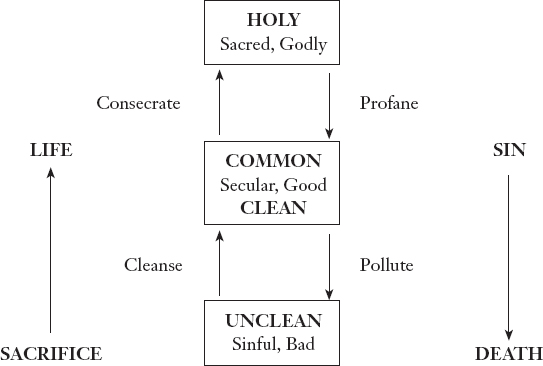
There are two processes going on. The first process is when sacred, godly, holy things are profaned and become common. You can spoil a holy thing by making it common. When the Bible Society sent Bibles to Romania, the communist government allowed the pages to be used in toilet rolls. It sparked a revolution started by Christians who were scandalized by this action. What had happened in that situation according to the teaching of Leviticus? In using the Bible for such a mundane though necessary purpose, a holy thing had been made common. The second process is when a common, clean thing is made unclean and sinful.


